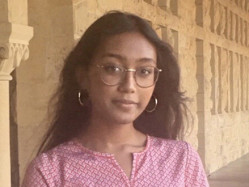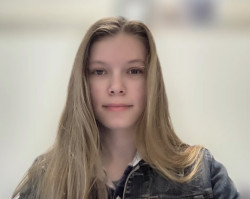Summer Program Sparks High School Students’ Interest in Quantum Computing
August 23, 2022
By Keri Troutman
Contact: cscomms@lbl.gov
In August, at the end of their summer internship in Berkeley Lab’s Applied Computing for Scientific Discovery (ACSD) group, two students presented their quantum computing projects in a virtual forum. “Their final joint presentation would have been impressive if it had come from college students,” said their supervisor, Bert de Jong, who leads the ACSD group in the Applied Mathematics and Computational Research Division. “But they were high school students. It was pretty unbelievable what they were able to learn.”

Shohini Sarkar
The students — Shohini Sarkar, a rising high school junior, and Sabina Sokol, a rising high school senior — applied for the internship through the Experiences in Research (EinR) program, a virtual internship for high school students to gain hands-on experience with professionals at Berkeley Lab. Students spend six weeks over the summer remotely working on cutting-edge projects alongside scientific experts.
Recruiting high school students to participate in a summer program was a first for de Jong, but he said it aligns with his mission to prepare students earlier to enter a quantum workforce. “For many years now, we’ve recruited undergraduate college students into our summer programs,” said de Jong. “But we have recognized that we need to start earlier and get them excited at the high school level.”

Sabina Sokol
Simulating Molecules
Sarkar and Sokol worked with de Jong and two of his postdoctoral researchers — Lindsay Bassman and Niladri Gomes — on a series of projects simulating molecules on quantum computers. “We had developed what we thought was going to be a complicated quantum computing project,” said de Jong. “But when we interviewed Shohini and Sabina, they blew us away, and we realized we might have to make the research they were going to work on a little more complicated. That’s how advanced they were.”
To run their simulations, the high school students had to install a lot of software, do their own Python programming, and do a lot of troubleshooting, de Jong said. “We thought just learning how to simulate molecules without noise on quantum computers would be enough for five weeks, but that was done after two,” said de Jong. “Then they had another couple of weeks where they learned about error mitigation, and we still had time to have them explore some materials simulations.”
Sarkar found out about the Berkeley Lab program from her math teacher at Fremont’s Mission San Jose High School. “I’ve always been interested in math and science, and I became more interested in machine learning through clubs on my school campus,” she said. “I saw a TED talk about quantum computing that really inspired me, so I researched it and took a few courses.”
After her experience at Berkeley Lab this summer, Sarkar is now considering quantum computing as a potential career path. “When I first started learning about quantum computing it didn’t seem like something that I could really practically apply; it was sort of this big ‘out-there’ concept with all of these spinning qubits in multiple states at once, and it felt like it wasn’t really something tangible,” she said. “But through this program the biggest takeaway I had was that quantum computing has real-life applications.”
“Our mentors at Berkeley Lab were so encouraging and accommodating and really just let us guide the way,” she added. “They were open to any ideas we had and gave us fantastic feedback.”
Research Collaborations Key
Sarkar’s fellow intern Sokol agreed and was particularly inspired by the chemistry simulations and the code developed for them by Bassman. “The most exciting thing about the program was really that I had the chance to work alongside postdoctoral researchers experienced in quantum,” said Sokol. “Seeing that even they have questions at their level of expertise was really interesting.”
Sokol found out about the Berkeley Lab program through a QubitxQubit quantum computing training program she participated in. “When I started my internship, I was confident that I understood basic quantum mechanics, but then I realized that the more I delved into quantum, the less I knew!” she said. Before her Berkeley Lab internship, Sokol thought that quantum was a “maybe” for her future studies, but after completing the program she’s now thinking about studying the intersection of quantum and cybersecurity.
Sokol serves as the U.S. ambassador of Girls in Quantum, an international organization focused on bringing as many female-identifying students into the field as possible. She’s the primary organizer for an upcoming webinar that will feature grad students, postdocs, and authors who will discuss a variety of quantum topics, including cryptography, machine learning, and algorithms.
Since completing this program at Berkeley Lab, Sarkar has been inspired to get more involved in the quantum computing club at her high school, working on developing curriculum and planning a quantum hack-a-thon, potentially drawing even more young people into the quantum computing realm — something that would please de Jong very much.
“Right now the quantum computing community just doesn’t have the people we need for what’s coming in quantum computing,” he said. “I really want these programs to draw younger people in, and especially bring women and under-represented groups to the table.”
About Computing Sciences at Berkeley Lab
High performance computing plays a critical role in scientific discovery. Researchers increasingly rely on advances in computer science, mathematics, computational science, data science, and large-scale computing and networking to increase our understanding of ourselves, our planet, and our universe. Berkeley Lab’s Computing Sciences Area researches, develops, and deploys new foundations, tools, and technologies to meet these needs and to advance research across a broad range of scientific disciplines.







 Instagram
Instagram YouTube
YouTube